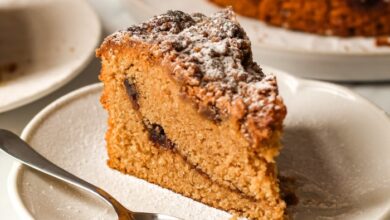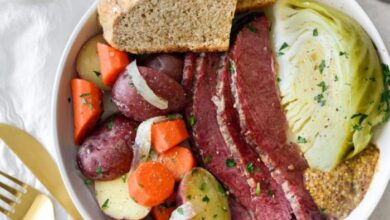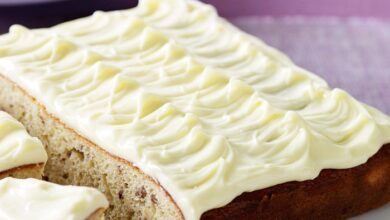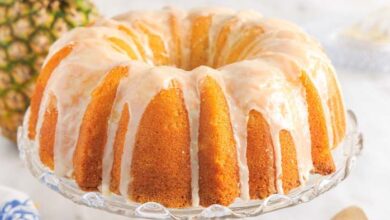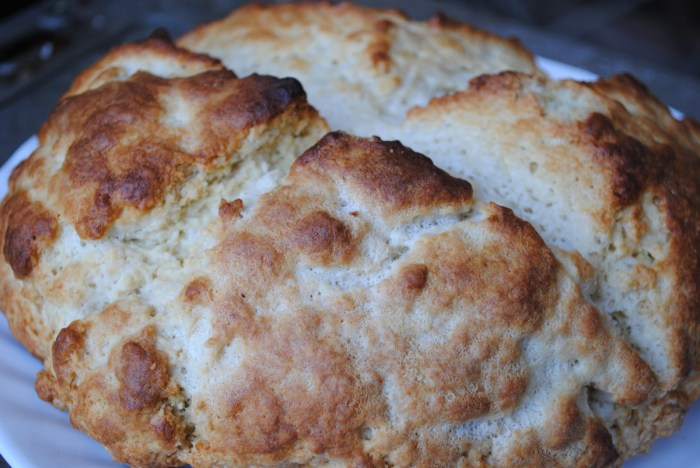
Irish Soda Bread: A Taste of History and Tradition
Irish soda bread i – Irish soda bread, a staple of Irish cuisine for centuries, is a simple yet delicious loaf that embodies the spirit of Irish tradition. Its origins are deeply rooted in Irish history, where it served as a hearty and comforting food for generations.
The unique texture and flavor of Irish soda bread are a result of its simple ingredients, including flour, buttermilk, baking soda, and salt. The absence of yeast allows for a quick and easy preparation, making it a popular choice for both experienced bakers and those just starting out.
The history of Irish soda bread is interwoven with the social and economic fabric of Ireland. It was often the centerpiece of meals, shared amongst families and friends, and played a significant role in Irish folklore and cultural identity. The recipe itself has evolved over time, with variations emerging based on regional preferences and available ingredients.
Today, Irish soda bread continues to be a beloved tradition, enjoyed both in Ireland and around the world.
Variations and Adaptations
The beauty of Irish soda bread lies in its adaptability. Beyond the classic recipe, there’s a world of variations to explore, each adding its own unique flavor and texture. From incorporating different flours and sweeteners to incorporating unexpected additions, the possibilities are endless.
Let’s delve into some popular variations and discover how baking methods influence the final product.
Fruit Soda Bread
Fruit soda bread is a delightful twist on the classic recipe, adding a burst of sweetness and texture. The addition of dried fruits, such as raisins, cranberries, or currants, creates a moist and flavorful bread that is perfect for breakfast, tea time, or as a dessert.
Irish soda bread is a staple in my kitchen, always comforting and familiar. It’s a simple recipe, but the texture is so satisfying – dense and slightly crumbly, perfect for slathering with butter. Sometimes I like to pair it with something sweet, like a slice of authentic key lime pie , the tartness of the citrus cutting through the richness of the bread.
But no matter what I serve it with, Irish soda bread always brings a touch of warmth and nostalgia to my table.
- Dried Fruit Choices:Choose dried fruits that complement the flavor profile you desire. Raisins are a classic choice, while cranberries add a tartness and currants provide a subtle sweetness.
- Fruit Ratio:The amount of fruit you add will influence the sweetness and texture. A good starting point is 1 cup of dried fruit per loaf.
- Soaking:Soaking dried fruits in hot water for 15-20 minutes before incorporating them into the dough will plump them up and enhance their flavor.
Cheese and Onion Soda Bread
Cheese and onion soda bread is a savory variation that is perfect for a hearty lunch or snack. The combination of sharp cheddar cheese and caramelized onions creates a flavorful and satisfying bread that is both comforting and delicious.
Irish soda bread is a staple in my kitchen, always a comforting presence. But sometimes, I crave something a bit more exotic, like the vibrant flavors of thai fried rice with pineapple and chicken. The sweet and savory combination is a delightful contrast to the simple, hearty goodness of soda bread.
But after a taste of that fragrant rice, I always find myself back to the comforting familiarity of a warm slice of soda bread, a reminder of home and tradition.
- Cheese Selection:Choose a sharp cheddar cheese that melts well, such as a mature cheddar or a sharp white cheddar.
- Onion Caramelization:Caramelizing the onions enhances their sweetness and creates a richer flavor. Slice the onions thinly and cook them over low heat with a little butter or oil until they are soft and golden brown.
- Cheese and Onion Ratio:The ratio of cheese to onion can be adjusted to taste. A good starting point is 1 cup of shredded cheese and 1/2 cup of caramelized onions per loaf.
Brown Soda Bread
Brown soda bread, made with whole wheat flour, offers a nutty flavor and a slightly denser texture compared to the classic white soda bread. It is a nutritious and flavorful option that is perfect for those seeking a more wholesome bread.
- Flour Blend:You can use 100% whole wheat flour or a blend of whole wheat and white flour for a lighter texture. A blend of 75% whole wheat and 25% white flour is a good starting point.
- Liquid Ratio:Whole wheat flour absorbs more liquid than white flour. You may need to add a little more buttermilk or water to achieve the desired dough consistency.
- Baking Time:Brown soda bread may take a little longer to bake than white soda bread due to the higher density of the whole wheat flour.
Nutritional Value and Health Benefits: Irish Soda Bread I
Irish soda bread, a staple in Irish cuisine, is a hearty and flavorful bread known for its unique texture and taste. While its origins are humble, it boasts a nutritional profile that makes it a worthwhile addition to a balanced diet.
Irish soda bread is a staple in my kitchen, always a comforting presence alongside hearty stews and soups. Sometimes, though, I crave something a bit more elaborate for dinner. That’s when I turn to dinner recipes that always work , like a flavorful chicken stir-fry or a comforting lasagna.
But no matter what I’m serving, a warm slice of Irish soda bread is always a welcome addition to the table.
Key Nutrients
Irish soda bread is a good source of several essential nutrients. Here’s a breakdown of its key components:
- Carbohydrates:The primary source of energy in Irish soda bread, primarily in the form of complex carbohydrates. These carbohydrates are digested slowly, providing sustained energy levels.
- Fiber:Rich in dietary fiber, Irish soda bread promotes digestive health and regularity. Fiber helps to regulate blood sugar levels, reducing the risk of chronic diseases like type 2 diabetes.
- Protein:While not a primary protein source, Irish soda bread provides a moderate amount of protein, contributing to muscle building and repair.
- Vitamins and Minerals:Irish soda bread contains essential vitamins and minerals, including thiamin, riboflavin, niacin, iron, and potassium. These nutrients play vital roles in maintaining overall health and well-being.
Health Benefits
The nutritional composition of Irish soda bread offers several potential health benefits:
- Improved Digestive Health:The high fiber content in Irish soda bread promotes regular bowel movements, reducing constipation and improving digestive health.
- Reduced Risk of Chronic Diseases:The fiber and complex carbohydrates in Irish soda bread help regulate blood sugar levels, reducing the risk of type 2 diabetes and heart disease.
- Increased Energy Levels:The slow-release energy from complex carbohydrates provides sustained energy levels, promoting focus and alertness.
- Weight Management:The high fiber content in Irish soda bread can promote satiety, helping to control appetite and potentially aiding in weight management.
Comparison to Other Breads
Compared to other types of bread, Irish soda bread stands out for its nutritional profile:
- White Bread:Irish soda bread is typically lower in refined carbohydrates and higher in fiber compared to white bread, making it a healthier choice.
- Whole Wheat Bread:While whole wheat bread is a good source of fiber, Irish soda bread often contains a higher percentage of whole grains, providing additional nutritional benefits.
- Sourdough Bread:Irish soda bread and sourdough bread both offer unique flavors and textures. However, Irish soda bread is generally lower in calories and fat compared to sourdough bread.
Serving and Pairing
Irish soda bread is a versatile food that can be enjoyed in a variety of ways. It is often served warm with butter or jam, but it can also be paired with a variety of other foods, such as soups, stews, cheeses, and salads.
The cultural context of serving Irish soda bread varies depending on the occasion and the region.
Traditional and Modern Ways to Serve Irish Soda Bread
Irish soda bread is traditionally served warm, often with butter or jam. It can also be served with a variety of other toppings, such as honey, cream cheese, or smoked salmon. In modern times, Irish soda bread is often served with a variety of accompaniments, such as salads, soups, and stews.
Pairing Irish Soda Bread with Different Foods, Irish soda bread i
Irish soda bread pairs well with a variety of foods, including:
- Soups and Stews: Irish soda bread is a classic accompaniment to hearty soups and stews, such as Irish stew, lentil soup, and vegetable soup. The bread’s dense texture and slightly sweet flavor complement the savory flavors of these dishes.
- Cheeses: Irish soda bread is a delicious pairing for a variety of cheeses, both hard and soft. Cheddar, Gouda, and brie are all good choices. The bread’s slight sweetness helps to balance the sharpness of the cheese.
- Jams and Preserves: Irish soda bread is often served with jams and preserves, such as strawberry jam, raspberry jam, and blackberry jam. The sweetness of the jam complements the bread’s slightly sweet flavor.
- Salads: Irish soda bread can also be served with salads, such as a simple green salad or a more elaborate salad with grilled chicken or fish. The bread’s texture and flavor add a satisfying element to the salad.
Cultural Context of Serving Irish Soda Bread
Irish soda bread is a staple food in Ireland and is often served at family gatherings, celebrations, and special occasions. It is also a popular food for picnics and outdoor events. In some regions of Ireland, Irish soda bread is traditionally served with a cup of tea or coffee.
Cultural Significance and Symbolism
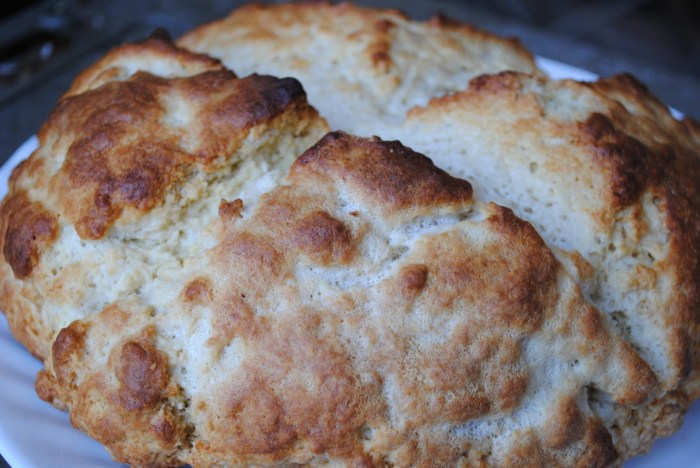
Irish soda bread holds a special place in Irish culture, symbolizing tradition, hospitality, and a strong connection to the land. It’s a staple food that has been baked for generations, passed down through families, and shared at gatherings, making it a symbol of Irish heritage and identity.
Role in Festivals and Celebrations
Irish soda bread plays a prominent role in various festivals and celebrations throughout Ireland. It is often served at traditional events like St. Patrick’s Day, where it represents the country’s heritage and is enjoyed by people from all walks of life.
Contemporary Trends and Innovations
Irish soda bread, a staple of Irish cuisine, has been undergoing a culinary renaissance in recent years, with bakers and food enthusiasts alike exploring new ways to elevate this classic bread. This resurgence is driven by a renewed appreciation for traditional recipes, a growing interest in artisanal baking, and the desire to experiment with innovative flavors and techniques.
Modern Baking Techniques and Ingredients
Modern baking techniques and ingredients play a crucial role in shaping contemporary Irish soda bread recipes. The availability of high-quality flours, including stone-ground whole wheat and spelt, allows bakers to create breads with richer flavor and texture. The use of sourdough starters and slow fermentation techniques, borrowed from other baking traditions, adds depth and complexity to the bread’s flavor profile.
Innovative Irish Soda Bread Recipes
The contemporary Irish soda bread scene is bursting with innovative recipes that showcase the versatility of this classic bread.
- Sweet and Savory Combinations:Many bakers are experimenting with incorporating sweet and savory flavors into their soda bread. For example, adding dried fruits, nuts, and spices like cinnamon and nutmeg to the dough creates a sweet and comforting bread that pairs well with cheese or butter.
Savory additions like herbs, cheese, and onions create a flavorful bread that can be enjoyed as a side dish or as part of a sandwich.
- Global Influences:Irish soda bread is increasingly incorporating global influences, drawing inspiration from cuisines around the world. For example, recipes incorporating ingredients like olives, sun-dried tomatoes, and feta cheese create a Mediterranean-inspired soda bread. The addition of Asian spices like ginger and sesame seeds creates a unique and flavorful twist on the classic recipe.
- Gluten-Free Variations:As gluten-free diets become more popular, bakers are developing innovative recipes for gluten-free Irish soda bread. These recipes often use a blend of gluten-free flours, such as almond flour, coconut flour, and tapioca flour, to achieve a texture and flavor that closely resembles traditional soda bread.
These recipes are also often enhanced with the addition of seeds and nuts for extra flavor and texture.

